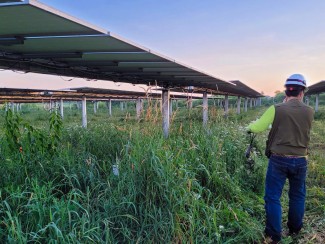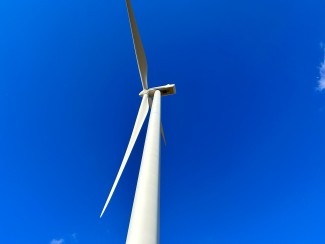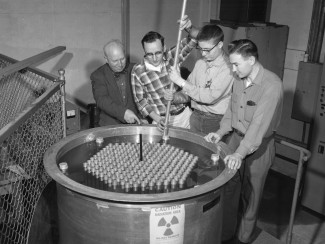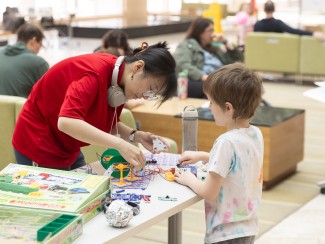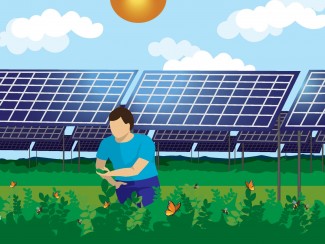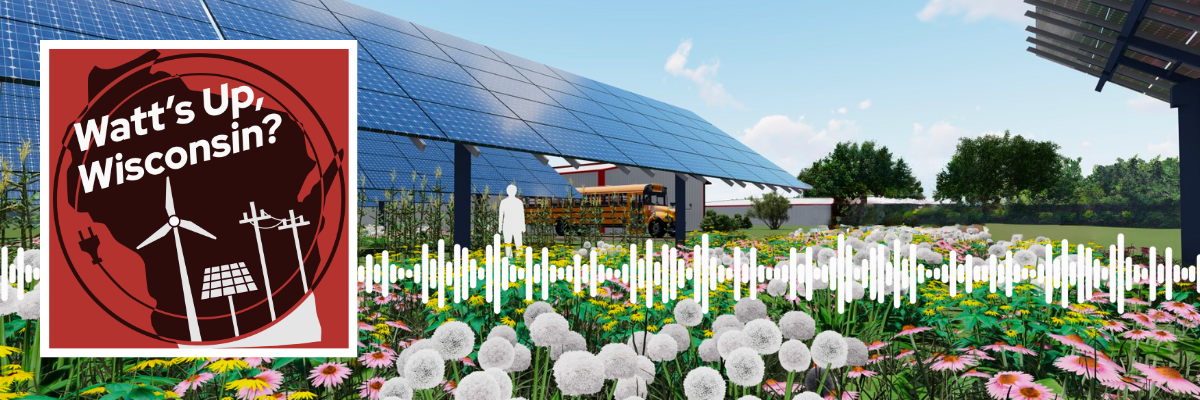
Solar and agriculture have one thing in common: they both need sunlight. Oftentimes, this puts them on opposing sides, competing for land space. However, what if solar and agriculture could live together?
In this episode of Watt’s Up, Wisconsin?, we explore the field of agriculture and photovoltaics, known as agrivoltaics and the possibilities in WI. We speak to UW-Madison’s Henry Hundt and Josh Arnold about the future of agrivoltaic research in Wisconsin.
Do you have a question about energy in Wisconsin? Ask the Wisconsin Energy Institute at communications@energy.wisc.edu or tweet us and tag #WattsUpWI.
Listen to Watt's Up, Wisconsin? on Apple podcasts, Spotify podcasts, Google Podcasts, Castbox, Youtube, or anywhere you find podcasts.
Learn more:
Kegonsa Research Campus Solar
Guests
 Henry Hundt, Sustainability Lead at Hoffman Planning, Design & Construction
Henry Hundt, Sustainability Lead at Hoffman Planning, Design & Construction
Henry holds a master of public affairs and energy, analysis, and policy certificate from University of Wisconsin–Madison. His master's work focuses on techno-economic modeling for storage and microgrids.
 Josh Arnold, UW-Madison’s Office of Sustainability Campus Energy Advisor
Josh Arnold, UW-Madison’s Office of Sustainability Campus Energy Advisor
Josh works with campus and community stakeholders to coordinate and implement energy efficiency and renewable energy projects that advance clean energy for people, planet and shared prosperity.
Credits
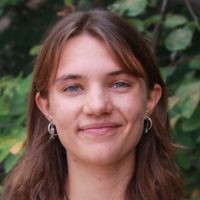 Britta Wellenstein, Host
Britta Wellenstein, Host
Britta is a Wisconsin Energy Institute communications intern and UW–Madison undergraduate majoring in Life Sciences Communication and Environmental Studies.
This episode was produced by Britta Wellenstein and Michelle Chung.
Theme music by Eden Comer.
Transcript
Britta Wellenstein: Imagine you're driving through rural of Wisconsin. You're surrounded on all sides by rolling hills and beds of crops, corn fields spread for miles, followed by cattle, pastures, ginseng crops, cranberry bogs and fields of potatoes. The sun beats down on your car and the fields. It's rays are the power that ultimately fuels the crops surrounding you.
But then you come across a field much like the others, but it soaks up the sun in a different way. A field of solar panels, also known as photovoltaics or PV. Agriculture and photovoltaics both utilize the sun's rays for energy, one as energy to grow and flower and the other as energy for electricity. But because of this shared interest, solar and agriculture are often on opposing sides, both competing for similar land space.
[MUSIC]
But what if agriculture and solar could work together on the same plot of land? Today on Watt's Up, Wisconsin, we'll be exploring agrivoltaics, an emerging energy solution, combining agriculture and photovoltaics, and answer the question what is agrivoltaics?
[light switch]
You're listening to Watt's Up, Wisconsin brought to you by the Wisconsin Energy Institute, where we explore your questions on energy in Wisconsin.
[cow moo]
I'm communications intern, Britta Wellenstein. Today we're looking at agrivoltaics. Wisconsin is already a powerhouse for agriculture. Agriculture makes up roughly 14 million acres of Wisconsin, which is around 40% of the state's dry land area. It's a huge economic driver in Wisconsin, contributing 104.8 billion to our state's economy every year, according to the Wisconsin Department of Agriculture.
To learn more about how solar can fit into this picture, I spoke to UW–Madison La Follette School of Public Affairs graduate Henry Hundt. Henry worked in Morgan Edwards Climate Action Lab and the Office of Sustainability on UW–Madison's campus. He now works for Hoffman Planning, Design, & Construction as a sustainability lead.
Britta Wellenstein: Could you kind of give me a basic definition of what agrivoltaics are?
It's kind of a jumbled word, I'd say.
Henry Hundt: Yeah, it is. It's better than an acronym because it's somewhat self-explanatory, but it does combine these two words photovoltaics and agriculture. Photovoltaics, obviously is generating energy from solar panels and agriculture is is using land for the production of food or energy through the growing of, you know, anything that's sort of organic. So you combine those two words together and that's the same thing that happens on agrivoltaics is that you're combining solar production of electricity with solar production of food or plants and using the same acre to do both.
Britta Wellenstein: Although it seems like having solar panels above crops would be counterintuitive by creating shade for plants, Henry says that by adding PV, you can actually create a cooling effect and a symbiotic relationship between the land and the solar panels.
Henry Hundt: Depending on where you are in the United States, there are different stresses that we see in our agricultural lands. In the west and the south you're dealing with drought, you're dealing with heat. And maybe in the Midwest or the Northeast, you might actually have issues with an abundance of pests or an abundance of, you know, could be even flooding issues or you often will have the same kind of drought issues as well, as we're seeing in large parts of Wisconsin this year.
So the introduction of PV into agricultural system can alleviate some of those issues. If you are planting in or around PV, you're going to have areas that are shaded, or partially shaded, and plants don't necessarily need direct access to the sun for the whole day. You know, just like humans, if you get too hot, they'll start to sweat and start to perspirate and they will lose some of that productivity or they will they will not need that excess solar energy.
And so it's trying to find that perfect balance between access to solar resources and making sure that they're not overly shaded. In this most current designs that we're considering for photovoltaics, there is the opportunity to also increase the efficiency of the modules themselves for the PV panels. And this is because when things are really hot, when you have drought conditions or you're having heat stress issues with your plants, panels will reduce in efficiency and become less efficient because just like plants, if they get too hot, they start to lose some of the max power output that they can provide.
And when a plant operates, it's there is a cooling, a slight cooling effect. So there is this kind of co-benefit that you're providing a little bit of cooling for the panels by having an active crop or some plant growing underneath and also that added shade for the plant underneath. So it's–there is this co benefit that's possible.
Britta Wellenstein: This co-benefit is determined by what types of crops are being grown because not all crops thrive with the little shade. The most common method is planting pollinator and prairie plants below panels and pairing that with honey production. We can also combine solar with grazing land, specifically with sheep.
Henry Hundt: It's kind of evolved into active vegetation management with sheep. So grazing operations, sheep obviously are more beneficial than, say, cows.
[cow moo]
Cows mainly because you're not gonna see that rubbing.Cows want to rub up against objects that they see and sheep are nimble and they go underneath the panels depending on various heights and are a bit better suited for those earlier PV utility photovoltaic designs.
Britta Wellenstein: But more recently, researchers are exploring how PV can coexist with food production, specifically with vegetable farming. Although we know plants need sun to grow, not all crops need sun all the time, and a little shade can even be beneficial. Ginseng, a huge crop in central Wisconsin, requires 70 to 90% shade, and in dry lands like Arizona, researchers found that tomatoes and peppers even grow better under PV panels since they favored the shade.
Henry Hundt: I think a lot of the research is happening in the West and in the south of the United States and in Europe. The evidence is very clear that for vegetable farming, for non large-scale corn and soybean farms, it is a very symbiotic relationship between PV and, and these crops.
Britta Wellenstein: Then with the height of it, because I'm imagining if someone's planting crops they have to get under and operate it. So is there a pushback from farmers in terms of understanding how they're actually going to harvest their crops with these PV panels?
Henry Hundt: Absolutely. And, you know, one common design variable takes is just spacing out the panels by using maybe twice as much space for the same amount of power production. You're going to allow a combine, you're gonna allow any sort of harvesting equipment you might want. However, these you know, these arrays at the at the leading edge are already quite high.
You know, usually the standard is on the lower side. So a panel tilted at 40 degrees, the lower edge would be four feet off the ground. At the high end, you might be, you know, eight, ten, 12 feet off. So there's plenty of space already for vegetables, and if you're doing any sort of non-equipment, agricultural activities underneath the panel.
Britta Wellenstein: This two-for-one land fit with solar and food production, provides economic incentives to farmers as well as another source of income.
Henry Hundt: I think the biggest challenges are combining both an educated developer and educated farmer about how they can both retain their goals. Because as a farmer, it's been well documented that if you were to lease your land for PV production, it's far more profitable than to go through the process of leasing it to any other agricultural activity by several orders of magnitude.
It's just a far more steady income.
Britta Wellenstein: So you're saying that installing PV is more profitable for a farmer?
Henry Hundt: Right. There's there's these are usually 20-year lease agreements. They are a guaranteed income, depending on the location of your farm as it relates to substation and the capacity substation. The payments can be quite high. But that relationship to the land changes dramatically. If you're going out to the land and farming every year, you have those normal rituals of the spring and the fall, planting and harvesting that all sudden disappears.
That can be like a very hollow relationship to your land. So I think that is maybe one of the opportunity of agrivoltaics is to facilitate the continuation of that ritual, but also to provide a source of renewable energy generation for the state.
Britta Wellenstein: There's huge potential for agrivoltaics in Wisconsin. Environmental organization, Clean Wisconsin, estimates that Wisconsin needs 300,000 acres of PV to hit net zero targets for power generation. That 300,000 acres is a small percentage of Wisconsin's agricultural land.
Henry Hundt: But 1 to 3% of that spend estimate that many other states have used in this kind of the overall estimate of land use needed for many of the net zero targets for the power sector. And it's important to note that I think what's really exciting about agrivoltaics is that that is that 300,000 acres is not been taken out of production.
Right? We know that the land underneath these arrays are alive. There's enough vegetation. They have to be managed. Every PV developer has a vegetation management cost that they include in their contracts. But if you're doing grazing, if you're growing potatoes and potatoes is a big crop here in Wisconsin, so is ginseng. These are crops that we have evidence that can do well underneath PV.
So there's opportunities to not even take land out of production, but rather just kind of use that solar energy twice, use it for electricity generation and then use it for the crops that are growing underneath.
[MUSIC]
Britta Wellenstein: However, despite the promising research into agrivoltaics, there is little practice of agrivoltaics in the Midwest and throughout the country. But this is about to change this fall, with one of the largest agrivoltaic research facilities in the country being built on the UW–Madison Kegonsa Research Campus near Stoughton, Wisconsin. The project will be owned and operated by Alliant Energy.
The 15 acre plot will generate 2.25 megawatts, which is enough to power 450 homes. To learn more about this project, we spoke to Josh Arnold, the campus energy advisor with the UW–Madison Office of Sustainability.
Britta Wellenstein: When did this project start? Can you provide me some background with what got this rolling?
Josh Arnold: We started working on this project back in 2020 and really the project came about from calls from students, staff and faculty for the institution to increase the amount of renewable energy on our campus and on our outlying properties. So really the genesis of this project was the leadership from students, especially calling for 100% renewable energy. So we started talking with smart people around campus and in the energy community about what might be possible for our institution to start to build out a clean energy portfolio and most importantly, what would that look like?
What would it look like to not only make progress towards our clean energy goals, but also create a living learning laboratory for students, for staff and faculty to explore different topics related not only to clean energy, but also about the rapidly changing landscape in Wisconsin and about how solar and renewable energy might coexist with agricultural activities?
Britta Wellenstein: This living laboratory will be made of three different sections of solar panels. One section will have Southern facing panels, much like the ones you'd see on a solar field. The next section will have rotating solar panels that follow the sun east to west. And the third section will have elevated solar panels tall enough for classes and demonstrations to gather underneath. These different sections will house a variety of research to help inform future agriculture projects in the Midwest.
Josh Arnold: Our goal with this pilot project is to help demonstrate how we can honor and respect our agricultural traditions and our agricultural activities, but then also create a bridge between all of that amazing work and to Wisconsin's clean energy future. What we're looking to be doing there is addressing different types of research about what are the impacts of solar panels on the immediate environment in which the solar panels are installed.
So looking at the impacts on soils, looking at the impacts of stormwater and groundwater, as well as looking at the impacts of the microclimate around the solar panels. So measuring the airspeed, temperature, humidity and that type of thing. In addition, we'll be exploring how pollinators and wildlife interact with solar panels and also how the area around this particular pilot project, how we might be able to implement some restorative ecology principles for some areas of the project that won't have solar panels directly tied to them.
So there's quite a bit there with the different types of biophysical research, as well as research with pollinators and wildlife and the surrounding environment. And then in addition, our extension team that we are collaborating with is actively working with agricultural producers in the area to better understand what types of policy questions there might be, what types of business model questions that we should be exploring, as well as how we can use this project to help demonstrate innovation in Wisconsin and how we might be able to feature different types of new technologies that will help make managing the site and managing the agricultural activities around the site even more efficient.
Britta Wellenstein: The project is still in planning and development phases, but groundbreaking is expected to start near the end of September, with solar panels and racking installed by the end of the 2023 year.
Britta Wellenstein: What do you see as the role agrivoltaics could play in Wisconsin's future and what this project will showcase for the possibilities in Wisconsin?
Josh Arnold: First, I think we have to just acknowledge in Wisconsin that large solar projects in Wisconsin are relatively new. It's really only been since 2018 or so that large projects have been developed here in Wisconsin. So, you know, when you think about 175 years of statehood plus, you know, all of the time that native nations and native peoples were here long before statehood, the clean energy transition in Wisconsin is really quite new.
And so because of that, I think we we collectively as a state are learning a lot with each project that comes down the line. And so really the goal for this pilot project is to help inform the discussion about, you know, what does the clean energy transition look like in Wisconsin and how do the costs and benefits of that clean energy transition, how do those translate to different stakeholders in different communities around the state?
We're hoping that this project will help inform other larger projects and help raise the profile of the possibilities of, you know, how how might we work together? We're hoping that instead of solar versus agriculture, instead of an either-or, we're hoping that this project will help demonstrate how it might be both-and.
[MUSIC]
Britta Wellenstein: Thanks for listening in. Do you have questions about energy? Wondering how new energy solutions are taking off in Wisconsin? Let us know by sending an email at communications@energy.wisc.edu or tweet @UWEnergy and tag #WattsUpWI.

